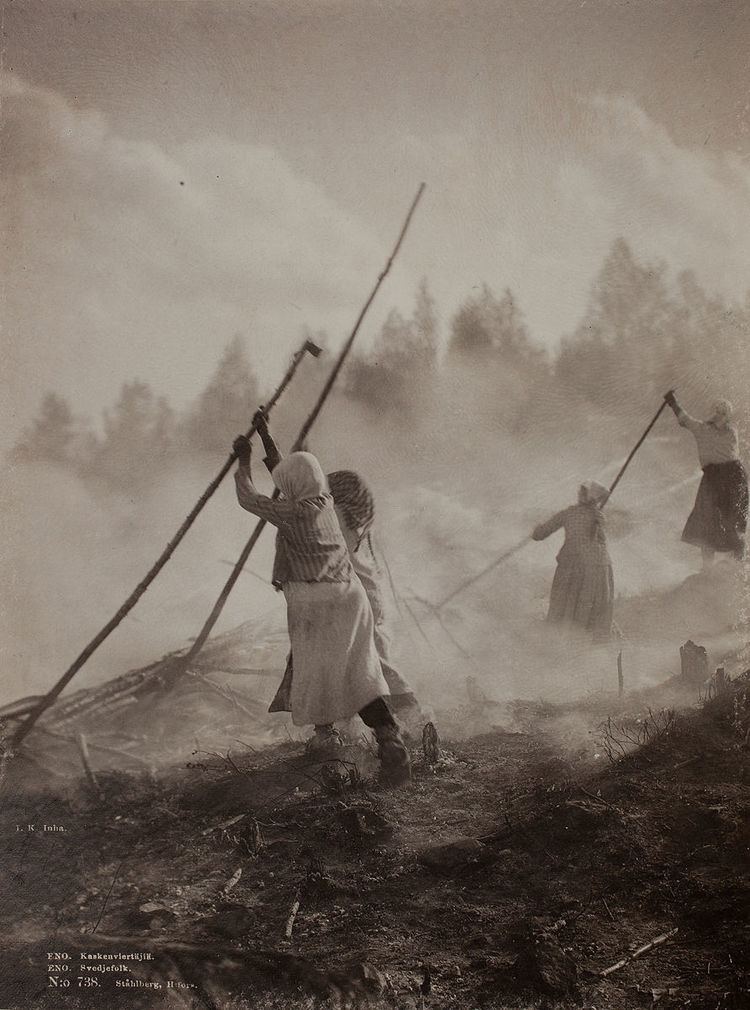 | ||
Slash-and-burn agriculture, or fire–fallow cultivation, is a farming method that involves the cutting and burning of plants in a forest or woodland to create a field called a swidden. (Preparing fields by deforestation is called assarting.) In subsistence agriculture, slash-and-burn typically uses little technology. It is often applied in shifting cultivation agriculture (such as in the Amazon rainforest) and in transhumance livestock herding.
Contents
Slash-and-burn is used by 200–500 million people worldwide. In 2004 it was estimated that in Brazil alone, 500,000 small farmers each cleared an average of one hectare (2.47105 acres) of forest per year. The technique is not scalable or sustainable for large human populations. Methods such as Inga alley farming have been proposed as alternatives which would cause less environmental degradation.
History
Historically, slash-and-burn cultivation has been practiced throughout much of the world, in grasslands as well as woodlands.
During the Neolithic Revolution, which included agricultural advancements, groups of hunter-gatherers domesticated various plants and animals, permitting them to settle down and practice agriculture, which provides more nutrition per hectare than hunting and gathering. This happened in the river valleys of Egypt and Mesopotamia. Due to this decrease in food from hunting, as human populations increased, agriculture became more important. Some groups could easily plant their crops in open fields along river valleys, but others had forests blocking their farming land.
In this context, humans used slash-and-burn agriculture to clear more land to make it suitable for plants and animals. Thus, since Neolithic times, slash-and-burn techniques have been widely used for converting forests into crop fields and pasture. Fire was used before the Neolithic as well, and by hunter-gatherers up to present times. Clearings created by fire were made for many reasons, such as to draw game animals and to promote certain kinds of edible plants such as berries.
Slash-and-burn fields are typically used and owned by a family until the soil is exhausted. At this point the ownership rights are abandoned, the family clears a new field, and trees and shrubs are permitted to grow on the former field. After a few decades, another family or clan may then use the land and claim usufructuary rights. In such a system there is typically no market in farmland, so land is not bought or sold in the open market and land rights are traditional. In slash-and-burn agriculture, forests are typically cut months before a dry season. The "slash" is permitted to dry, and then burned in the following dry season. The resulting ash fertilizes the soil and the burned field is then planted at the beginning of the next rainy season with crops such as upland rice, maize, cassava, or other staples. Most of this work is typically done by hand, using such basic tools as machetes, axes, hoes, and makeshift shovels.
Large families or clans wandering in the lush woodlands long continued to be the most common form of life through human prehistory. Axes to fell trees and sickles for harvesting grain were the only tools people might bring with them. All other tools were made from materials they found at the site, such as fire stakes of birch, long rods (vanko), and harrows made of spruce tops. The extended family conquered the lush virgin forest, burned and cultivated their carefully selected swidden plots, sowed one or more crops, and then proceeded on to forests that had been noted in their wanderings. In the temperate zone the forest regenerated in the course of a lifetime. So swiden was repeated several times in the same area over the years. But in the tropics the forest floor gradually depleted. It was not only in the moors, as in Northern Europe, but also in the steppe, savannah, prairie, pampas and barren desert in tropical areas where shifting cultivation is the oldest type of farming (Clark 1952 91–107).
Ecological implications
Although a solution for overpopulated tropical countries where subsistence agriculture may be the traditional method of sustaining many families, the consequences of slash-and-burn techniques for ecosystems are almost always destructive. This happens particularly as population densities increase, and as a result farming becomes more intensively practiced. This is because as demand for more land increases, the fallow period by necessity declines. The principal vulnerability is the nutrient-poor soil, pervasive in most tropical forests. When biomass is extracted even for one harvest of wood or charcoal, the residual soil value is heavily diminished for further growth of any type of vegetation.
Sometimes there are several cycles of slash-and-burn within a few years' time span. For example, in eastern Madagascar, the following scenario occurs commonly. The first wave might be cutting of all trees for wood use. A few years later, saplings are harvested to make charcoal, and within the next year the plot is burned to create a quick flush of nutrients for grass to feed the family zebu cattle. If adjacent plots are treated in a similar fashion, large-scale erosion will usually ensue, since there are no roots or temporary water storage in nearby canopies to arrest the surface runoff. Thus, any small remaining amounts of nutrients are washed away. The area is an example of desertification, and no further growth of any type may arise for generations.
The ecological ramifications of the above scenario are further magnified, because tropical forests are habitats for extremely biologically diverse ecosystems, typically containing large numbers of endemic and endangered species. Therefore, the role of slash-and-burn is significant in the current Holocene extinction.
Slash-and-char is an alternative that alleviates some of the negative ecological implications of traditional slash-and-burn techniques.
